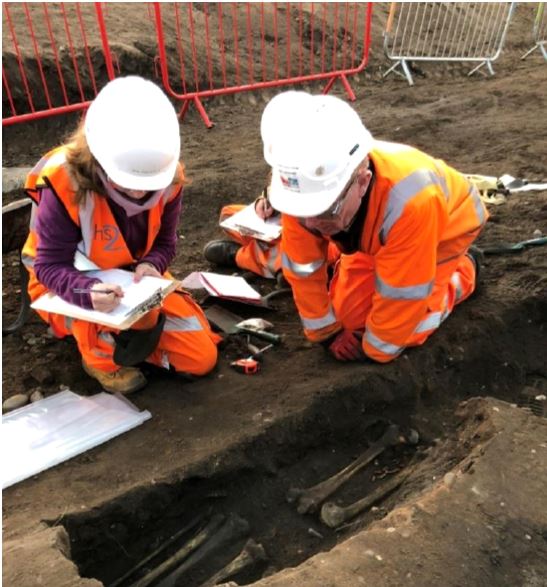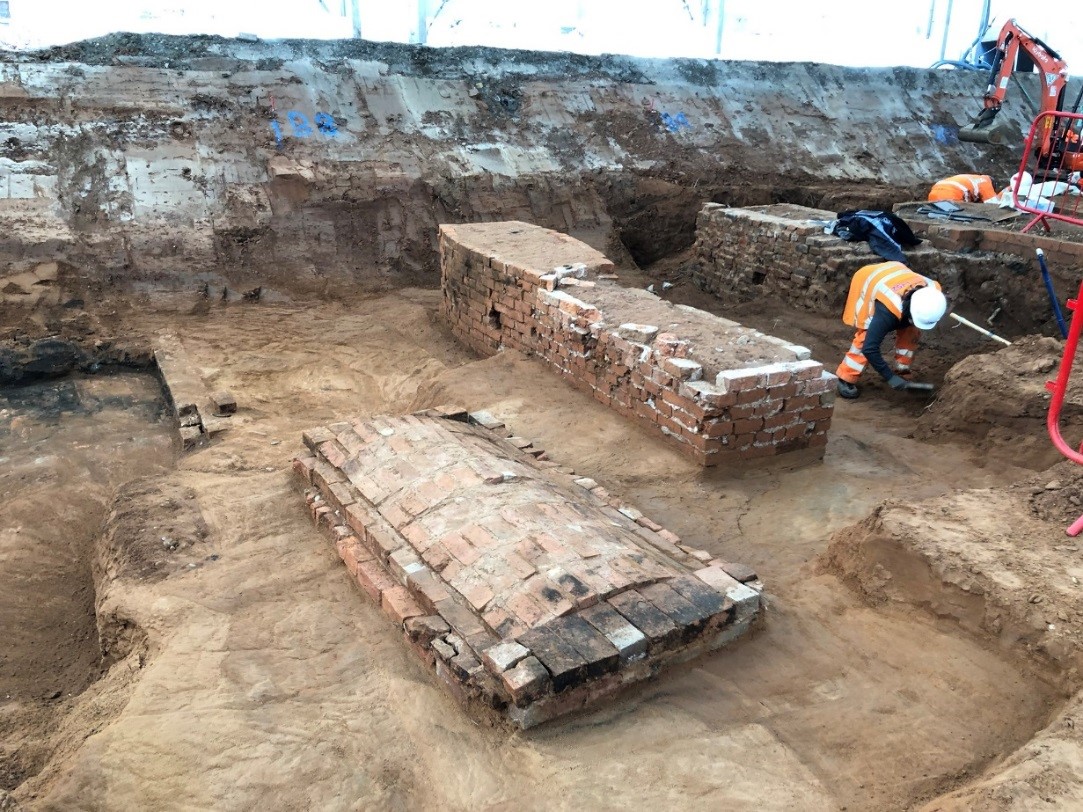Home
Archaeology
Archaeology
The creation of HS2 will be the biggest infrastructure project in Europe. The first new intercity railway to be built north of London in over a century.
But before we build bridges, tunnels, tracks and stations, an unprecedented amount of archaeological work will take place along the line of route.
HS2’s archaeology programme is a once-in-a-generation opportunity that will allow us to reveal over 10,000 years of British history, covering the Prehistoric, Romano-British, Anglo-Saxon and Medieval periods as well as the Industrial Revolution and World War Two.
The sheer scale of possible discoveries, the geographical span of the project and the vast range of our history to be unearthed makes HS2’s historic environment programme a unique opportunity to tell the story of Britain, its past and future.
Visit the HS2 website to find out more about HS2’s historic environment and archaeology programme .
Archaeology in BirminghamThere are a number of archaeological sites that we will be exploring across the city. These include:
The archaeological potential of Birmingham from Park Hall to Curzon Street/Park Street is as diverse as the city is today. There has been recorded settlement in Birmingham prior to the time of Domesday, (1086), where the survey by William the Conqueror created an inventory of all taxable land and property within England. There is evidence, albeit limited, for Anglo-Saxon occupation within the Birmingham area, there are also possibilities for Norman and Medieval archaeology findings along the Birmingham spur in pockets west of Park Hall. The most likely findings will be for post medieval activities including; industrial works such as tanneries, dye works, metal working - smithing, watermill sites and textiles throughout the Birmingham Spur. Birmingham was a great industrial powerhouse and was lauded during the 19th century as the first truly manufacturing centre, the city of a ‘thousand trades’. The area around Curzon Street may yield evidence of this industrial diversity with the remains of earlier factories, tanneries and mills, and through the analysis of human remains and funerary monuments at Park Street burial ground.
Industrial archaeology is represented in the extant canals and rail infrastructure evident throughout Birmingham. Although Birmingham’s recent past is obvious and can be viewed all around the city, its prehistoric past is much more secretive and elusive. This prehistoric landscape will be revealed through selective geo-archaeological surveys, mapping the courses of the many underground (paleo-channels) prehistoric river channels that may once have held early prehistoric activities for Palaeolithic and later Mesolithic hunter gatherers, like fishing and tool making. All of the above may be revealed through the survey and study of past human activity and occupation as part of the enabling works along the route of HS2, from Park Hall to Park Street.
For more information, please click on the links below:
Burial Grounds information paper
Digbeth Self-Guided WalkOnce on the outskirts of a rural market town surrounded by orchards and water meadows, Digbeth developed into a slum in the 19th century with the highest population density the city has ever seen. Today, the area is changing again as work gets underway for the new HS2 railway. Now, you can explore the historical delights of Digbeth for yourself with our one-hour self-guided walk . The walk charts Digbeth's transformation from open fields to one of Britain's industrial powerhouses.
Archaeology at Park Street GardensEvery month we publish an archaeology blog, direct from our contractors on site at Park Street Gardens. Visit the blog at the bottom of this page to read the latest exciting news and discoveries from the site.
The History:
The area around Park Street Gardens was originally a deer park during the medieval and post medieval periods (Little or Over Park), the park was situated on the eastern edge of the market town of Birmingham. During the late 18th century Birmingham became a significant industrial city and its urban population expanded close to the area that is now Park Street, which was still parkland.
The parish church of St. Martin in the Bullring and its chapel of ease, St Bartholomew, could no longer contain the pressure on their combined burial grounds, due to the high density of population growth within this part of industrial Birmingham. The parkland to the east was purchased in 1807 by the church, and became an additional burial ground for the parish, opened in 1810. Park Street burial ground was is use for 63 years and was disused as a burial ground for public burials by 1873, the last recorded burial in a family vault was in 1893. Thereafter, Park Street became open recreational area, and finally public gardens.
What has happened at Park Street Gardens since work began on HS2?
Work began in October 2017 to investigate the historic site, and removal of the burial ground began in October 2018. All human remains discovered during work for HS2 are treated with dignity, care and respect, in the manner of their removal from the ground, in the way they are looked after while out of the ground and in the manner of their reburial.
In accordance with HS2’s commitments to the Church of England, approximately 10,000 individuals have been removed from Park Street Gardens by the project’s archaeological specialists, by careful hand excavation, liaising closely with the Church and Historic England.
In accordance with the High Speed Rail Act (2017) and a legal Undertaking with the Church of England, these remains will all be reburied in consecrated ground. Following a formal selection process involving key stakeholders, Witton Cemetery in Birmingham was chosen as the receiving burial ground for the Park Street Gardens buried population. Witton was selected due to its proximity within the city and the Diocese, and its urban parkland setting which is similar to that of Park Street Gardens.
A monument to the those buried at Park Street Gardens will be erected in Witton cemetery in due course and the surviving headstones from Park Street relocated to the new burial site. Around half of the population from Park Street Gardens have already been reburied at Witton and the remaining individuals will be reburied in the coming months.
An archaeological research program is ongoing, looking at a sample of these remains currently held in safe storage, to examine aspects of life in nineteenth century Birmingham.
Remains of the world's oldest railway roundhouse at Curzon Street
Our team of archaeologists has unearthed what is thought to be the world’s oldest railway roundhouse at the construction site of Birmingham Curzon Street station.
The roundhouse was situated adjacent to the old Curzon Street station, which was the first railway terminus serving the centre of Birmingham and built during a period of great significance and growth for the city. Built to a design by the 19th century engineer Robert Stephenson, the roundhouse was operational on 12 November 1837 – meaning the recently discovered building is likely to predate the current titleholder of ‘world’s oldest’ in Derby by almost two years.
The 19th century station at Curzon Street is among the very earliest examples of mainline railway termini and the limited later development of the site means that any surviving remains of the early station represents a unique opportunity to investigate a major early railway terminus in its entirety.
Find out more about the discovery on the HS2 website: https://mediacentre.hs2.org.uk/news/hs2-uncovers-worlds-oldest-railway-roundhouse-at-curzon-street-archaeological-site
Remains of Curzon Street Station Yard UncoveredThe History:
The car park to the south of Curzon Street, opposite Millennium Point, was the home of the first railway terminus in central Birmingham that opened in 1838-9. The London & Birmingham and the Grand Junction railways each had a station on this site. When New Street Station opened in the 1850s Curzon Street Station was converted into a Goods Office to service freight traffic on the railway until its closure, and demolition in 1966.
Work begins:
During Ground Investigation works in the car park a series of structural assessments have been carried out. This revealed the buried features which have been identified as possibly the foundations of post medieval buildings. It is likely that these represent the foundations and relics of the early mid-19th Century Goods Station. Archaeological investigation of this area is scheduled to begin in autumn 2018. The work undertaken by HS2 at Curzon Street and Park Street is likely to greatly enhance our understanding of the social and industrial history of the city of Birmingham.

Old Curzon Street Station Good Office - 1913
Freeman Street Baptist Meeting HouseThe History:
A Baptist Meeting House and Burial Ground was licenced for public worship on Freeman Street (now part of a car park at the back of Moor Street Station) in 1729. The meeting house was only open for a short period as it closed between 1752 and 1754. The meeting house was the earliest known Baptist Meeting House in Birmingham.
The meeting house was adapted for various uses until it was finally demolished in 1856 and the site was re-developed for the construction of a warehouse. The site remained in industrial use until the area was cleared in the early 2000s, to make way for a car park.
Work begins:
HS2 is considering how to carry out the potential burial ground excavations in this area. We are talking to the Heart of England Baptist Association about how we can ensure we treat any burial grounds with due dignity, care and respect. Archaeological investigations in this area are scheduled to begin in the autumn of 2018.
Built heritage surveys at Saltley and Washwood HeathThe History:
The sites at Saltley and Washwood Heath formed part of the Midland Carriage Works (later known as Metro-Cammell and Alstom), and produced train carriages for railways around the world from the middle of the 19th century until the closure of the Washwood Heath site in 2004, when the last Pendolino train was completed.
During the First World War the Washwood Heath works were converted for use as the Birmingham National Shell (munitions) Factory. Then during the Second World War the site was used to produce a variety of different types of tanks which they supplied in substantial numbers to the British Army during the war.
Work begins:
The sites at Saltley and Washwood Heath include several of the original historic, industrial buildings. Prior to the demolition of these buildings, we carefully recorded what was there.
We understand that the Midland Carriage Works was a focal point for local people, so a programme of community engagement is being organised to record the local community’s memories of the works. This will be added to the official historic building records to create a fuller documented history of these historic buildings.

Saltley Carriage Works - 1888

Washwood Heath Carriage works - 1913
If you have any questions or comments please contact HS2enquiries@hs2.org.uk or call 08081 434 434 and refer to "HS2 in Birmingham".
Additional materials














This engagement phase has finished
